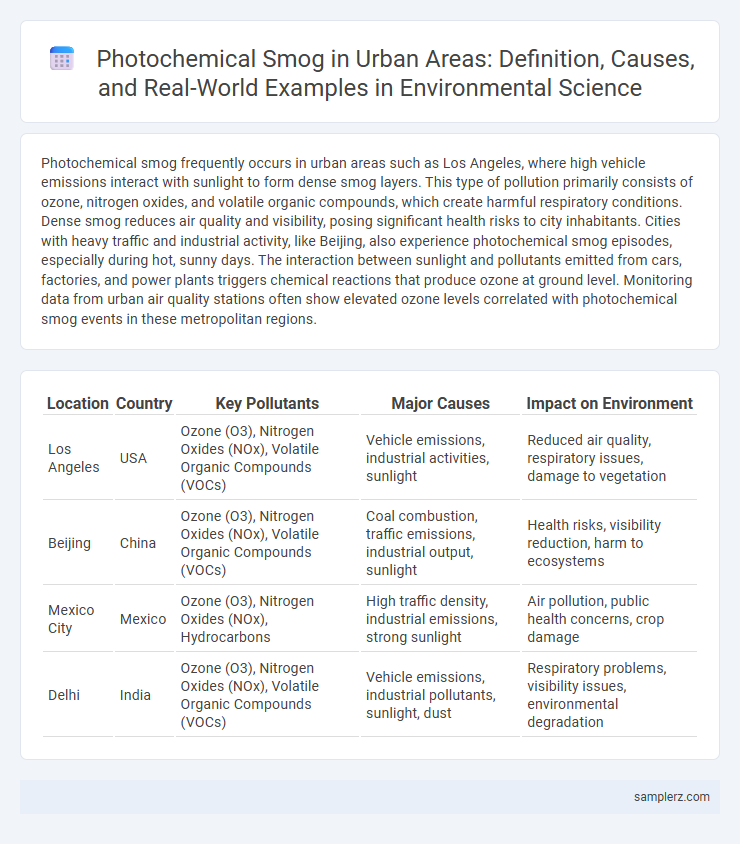Photochemical smog frequently occurs in urban areas such as Los Angeles, where high vehicle emissions interact with sunlight to form dense smog layers. This type of pollution primarily consists of ozone, nitrogen oxides, and volatile organic compounds, which create harmful respiratory conditions. Dense smog reduces air quality and visibility, posing significant health risks to city inhabitants. Cities with heavy traffic and industrial activity, like Beijing, also experience photochemical smog episodes, especially during hot, sunny days. The interaction between sunlight and pollutants emitted from cars, factories, and power plants triggers chemical reactions that produce ozone at ground level. Monitoring data from urban air quality stations often show elevated ozone levels correlated with photochemical smog events in these metropolitan regions.
Table of Comparison
| Location | Country | Key Pollutants | Major Causes | Impact on Environment |
|---|---|---|---|---|
| Los Angeles | USA | Ozone (O3), Nitrogen Oxides (NOx), Volatile Organic Compounds (VOCs) | Vehicle emissions, industrial activities, sunlight | Reduced air quality, respiratory issues, damage to vegetation |
| Beijing | China | Ozone (O3), Nitrogen Oxides (NOx), Volatile Organic Compounds (VOCs) | Coal combustion, traffic emissions, industrial output, sunlight | Health risks, visibility reduction, harm to ecosystems |
| Mexico City | Mexico | Ozone (O3), Nitrogen Oxides (NOx), Hydrocarbons | High traffic density, industrial emissions, strong sunlight | Air pollution, public health concerns, crop damage |
| Delhi | India | Ozone (O3), Nitrogen Oxides (NOx), Volatile Organic Compounds (VOCs) | Vehicle emissions, industrial pollutants, sunlight, dust | Respiratory problems, visibility issues, environmental degradation |
Understanding Photochemical Smog and Its Urban Impact
Photochemical smog, commonly observed in urban areas like Los Angeles, forms when sunlight reacts with nitrogen oxides and volatile organic compounds emitted from vehicles and industrial sources. This smog significantly degrades air quality, causing respiratory problems and reducing visibility. Understanding its formation helps urban planners implement stricter emission controls and promote cleaner transportation alternatives.
Key Components of Photochemical Smog in Cities
Photochemical smog in urban areas primarily consists of nitrogen oxides (NOx) and volatile organic compounds (VOCs) emitted from vehicle exhaust and industrial activities. These pollutants react under sunlight to form ozone (O3), a major oxidant contributing to respiratory problems and environmental damage. Secondary components like peroxyacetyl nitrates (PANs) and aldehydes further exacerbate air quality issues, making the smog a complex mixture of harmful substances.
Major Urban Sources Contributing to Photochemical Smog
Major urban sources contributing to photochemical smog include vehicular emissions, industrial activities, and power plants, all releasing significant amounts of nitrogen oxides (NOx) and volatile organic compounds (VOCs). These pollutants react under sunlight to form ozone and other harmful oxidants, intensifying smog conditions in cities like Los Angeles and Beijing. Traffic congestion and fossil fuel combustion remain primary drivers of elevated photochemical smog levels in densely populated urban environments.
Photochemical Smog Formation: Chemical Processes in Cities
Photochemical smog in urban areas forms through complex chemical reactions involving nitrogen oxides (NOx) and volatile organic compounds (VOCs) under sunlight, producing ozone (O3) and secondary pollutants. Key processes include the photolysis of nitrogen dioxide (NO2) releasing atomic oxygen, which reacts with molecular oxygen (O2) to form ozone. Elevated levels of solar radiation and vehicular emissions in cities like Los Angeles accelerate these photochemical reactions, contributing to hazardous smog episodes.
Notable Global Examples of Photochemical Smog in Urban Areas
Los Angeles, California, experiences severe photochemical smog due to high vehicle emissions combined with sunny weather and geographical basin effects. Mexico City faces significant photochemical smog episodes caused by industrial pollution and dense traffic in a valley surrounded by mountains. Beijing, China, is another notable urban area suffering from photochemical smog driven by rapid urbanization, coal combustion, and vehicle exhaust.
Case Study: Los Angeles and Persistent Smog Episodes
Los Angeles experiences severe photochemical smog episodes primarily due to its heavy vehicle emissions, abundant sunlight, and geographic basin that traps pollutants. The persistent smog consists of ozone and nitrogen oxides formed through complex chemical reactions driven by ultraviolet radiation. These smog episodes significantly impact public health, causing respiratory problems and reducing air quality over extended periods.
Photochemical Smog Events in Beijing and Their Effects
Photochemical smog events in Beijing frequently occur during summer months when high levels of nitrogen oxides (NOx) and volatile organic compounds (VOCs) from vehicle emissions and industrial activities react under strong sunlight. These smog episodes significantly reduce visibility, elevate ground-level ozone concentrations, and aggravate respiratory problems among urban residents. Studies indicate that peak smog days correspond with a 20-30% increase in hospital admissions for asthma and other pulmonary diseases in Beijing.
Health Impacts of Urban Photochemical Smog
Photochemical smog in urban areas, such as Los Angeles, significantly worsens respiratory conditions like asthma and bronchitis due to elevated ground-level ozone and nitrogen oxides. Prolonged exposure increases the risk of chronic lung diseases and cardiovascular problems, contributing to higher rates of hospital admissions. Vulnerable populations, including children and the elderly, face amplified health risks from persistent smog pollution.
Policy Responses and Control Measures in Urban Environments
Strict regulations on vehicle emissions and industrial pollutants are key policy responses to control photochemical smog in urban areas like Los Angeles, where smog episodes frequently exceed health-based air quality standards. Implementation of low-emission zones and promotion of public transportation reduce nitrogen oxides (NOx) and volatile organic compounds (VOCs), primary precursors to ozone formation. Urban planning measures, including green space expansion and clean energy incentives, further mitigate photochemical smog by enhancing air quality and reducing reliance on fossil fuels.
Future Trends and Solutions for Reducing Photochemical Smog in Cities
Urban areas such as Los Angeles, Beijing, and Mexico City showcase severe photochemical smog caused by vehicle emissions and industrial activities. Future trends emphasize the adoption of electric vehicles, enhanced air quality monitoring using IoT devices, and stricter emission regulations to mitigate smog formation. Implementation of green infrastructure, such as urban forests and green roofs, plays a crucial role in absorbing pollutants and improving overall urban air quality.

example of photochemical smog in urban area Infographic
 samplerz.com
samplerz.com